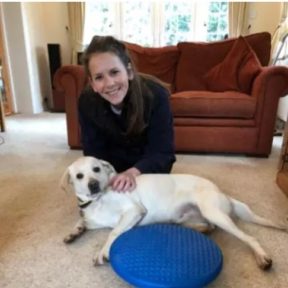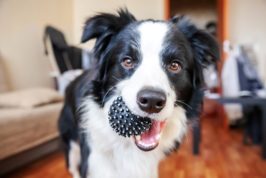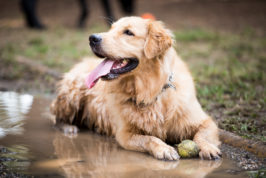Dog physiotherapy exercises
Canine physiotherapist, Kathryn Hall, talks to Pet Active Life about the benefits of dog physiotherapy…

What is physiotherapy for dogs?
What is dog physiotherapy and how can it help?
Veterinary physiotherapy is the functional assessment and treatment of animals with musculoskeletal or neurological conditions/injuries. It’s used alongside veterinary care, in order to help treat the animal and help reduce pain and restore normal movement. It can also be used to help strengthen performance animals, and therefore reduce the chance of injury. It can help in many ways, such as reducing pain, increasing movement, range of motion and flexibility, reducing stress and anxiety and improving general mood.
Which dog breeds do you typically see/treat most and why?
Although some breeds are more predisposed to certain conditions due to their genetics, the environment plays a massive role as well, so I see a variety of different breeds. For example, Hip Dysplasia is more common in Labradors, and Intervertebral Disc Disease is more common in your longer-backed breeds, such as Dachshunds. That said, if a dog is doing a lot of high-impact exercise (such as agility training) this can increase its chances of getting injured. The same can be said if your dog is overweight, as this puts more strain on the joints.
How do you get started?
What’s the assessment process to understand what to treat first, and what are the tools you use to do this?
First, a full history of the animal is taken. This includes previous injuries, exercise regimes, past owners etcetera. Then, a full static examination is taken, which explores things like the animal’s posture and anatomy. This is followed by a dynamic assessment of the dog in walk and trot to see how it moves in a straight line. Then, a range of motion of all joints is performed, looking at whether there are any restrictions, for instance, crepitus (popping, snapping or clicking sounds) or heat. Finally, I’ll assess the whole body with my hands to feel for any abnormalities.
Recommended physiotherapy exercises
Can you describe some of the exercises you recommend?
Here are a few exercises I often recommend. Word of warning, though – it’s really important that you don’t perform these unless under the instruction of a veterinary physiotherapist!
1. Static weight shifts

Dogs will often compensate. For example, if a dog has stiff joints in their hind legs, they will ‘front load’, putting more weight on their front legs and putting these joints under more strain, as well as increasing muscle mass on the forelimbs and reducing it on the hindlimbs. Static weight shifts are a simple, yet effective exercise which helps to encourage more even weight bearing, and therefore muscle mass, helping to reduce uneven forces on different joints and keep the joint more supported. For hindlimb weight shifts, you’d make sure the dog is standing square, place a hand over each hip joint to support the dog, and gently sway him side to side in a slow, controlled motion. This is a very subtle movement, and the dog shouldn’t move its legs while doing it.
2. Sit to stand
This is the canine equivalent of a squat. The idea is to help your dog build up the muscles around their hip and knee joints in a slow and controlled way. Essentially, you ask your dog to sit, then stand. It’s a simple exercise, but your dog needs to sit and stand up straight – in what we call the ‘sagittal plane’. This means standing up without bending over to one side, which your dog might tend to do in order to compensate. For example, if your dog always sits or lies to one side, this could be a sign that it’s uncomfortable for them to lie on the opposite leg.
3. Cavaletti poles

This is a great exercise to help increase range of motion, coordination and more even weight bearing on each leg. For example, if a dog has reduced range of motion in its back legs, the back paws do not have the flexibility to reach as far forward. Cavaletti poles encourage them to lengthen their stride to get over the pole, increasing the range of motion. As well as this, it encourages more even weight bearing and re-education in a dog that’s been compensating, which in turn will lead to more even muscle mass. In this exercise, it’s important that the poles are the right distance apart from each other, are in a straight line and are a suitable height for the dog. These should always be started as ground poles and slowly increased as and when your physiotherapist suggests.
How often should these exercises happen and how many reps should you do?
This totally depends on the animal case! That’s why you should never perform these exercises without first receiving guidance from a veterinary physiotherapist. Doing these exercises without proper guidance could cause harm to your dog, as not all of them will be suitable. These are just some examples to give you a good idea of what a physiotherapist may recommend.
What’s the outcome of physiotherapy?
There are many outcomes of physiotherapy, and it depends on the case. Sometimes, it’s used to help animals recover from injury, other times to help manage a condition or to help reduce the chance of injury and increase performance.
When shouldn’t physiotherapy be used for dogs?
Veterinary physiotherapy is only under the guidance of veterinary referral, as it must be deemed appropriate for the dog at that time. If physiotherapy is performed too soon it could do more harm than good. Also, the exercises recommended vary in each case. For example, a dog that’s just had a cranial cruciate ligament repair should avoid any movement that’s going to twist the joints. Later down the rehabilitation plan, though, this could be beneficial. Timing is key!
Physiotherapy has lots of benefits, as we’ve explored, but it isn’t the only option for your dog. Here are some other treatments to consider. Click on the links below to find out more…
- Hydrotherapy
- Acupuncture
- Supplementation
- Weight management




